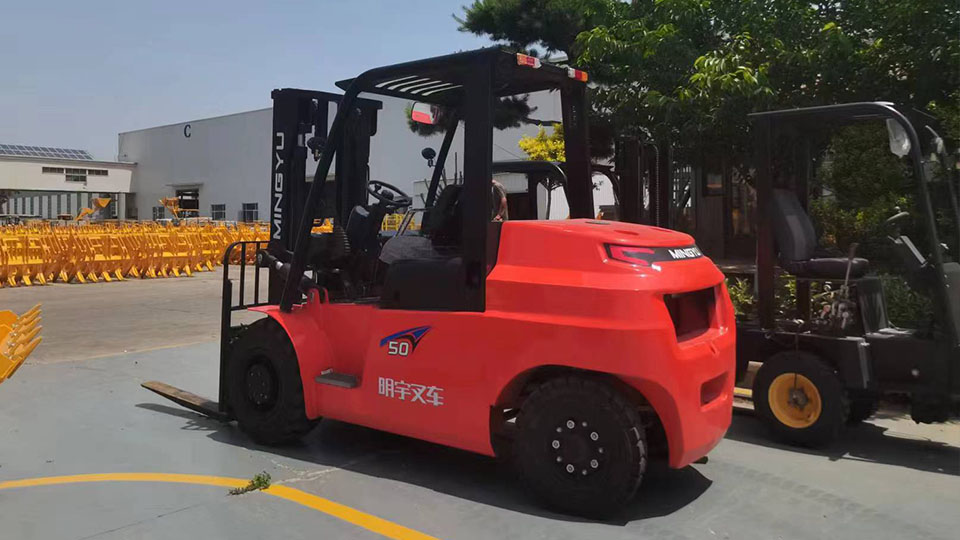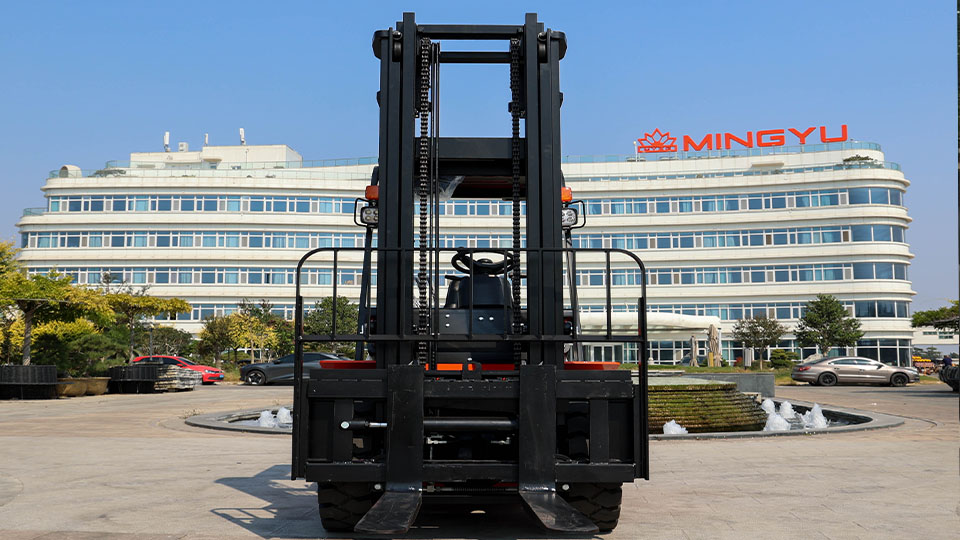
Executive Summary
Outdoor construction sites present a unique matrix of challenges—ungraded fill, loose aggregate, mud, snow, 6 %–12 % grades, confined staging areas, and the need to reach elevations from grade-level off-loading to 4-story structural steel. After evaluating lift capacity, terrain stability, reach envelope, fuel logistics, attachment versatility, and total cost of ownership, the data converge on a clear hierarchy:
Rough-terrain straight-mast forklifts (Class VII) remain the baseline for pure “forklift” duties—palletized brick, block, scaffolding, and drywall—up to 8 m lift height.
Telescopic handlers (telehandlers) with 4-wheel drive and 360° rotation dominate any task above 8 m or where horizontal reach over obstacles is required, and can substitute for small mobile cranes or elevated work platforms.
Heavy-duty counterbalance pneumatics (Class V) serve only when the site has been graded and compacted, or when the budget cannot justify the premium of Class VII suspension and ground-clearance.

Electric counterbalances are viable only on finished concrete slabs or inside enclosed buildings—well outside the scope of this guide.
Below we dissect the engineering parameters, regulatory constraints, and real-world economics that lead to these conclusions.
Site Characterization & Duty Cycle
Before matching iron to dirt, quantify:
• Terrain profile: % grade, ruts ≥100 mm, soil bearing ≥200 kPa, presence of ice or mud.
• Load spectrum: typical 2.5 t palletized materials, 4.5 t HVAC units, 6 m long formwork.
• Vertical envelope: 3 m truck-bed height, 6 m second-floor deck, 12 m roof steel.
• Horizontal reach: placing bundles across 4 m-wide footings, over parapets, or into scaffolding bays.
• Run-time: 8–10 h shifts, no shore-power for charging.
• Manuever space: 4 m-wide access roads, 6 m turning radius.
These vectors immediately disqualify cushion-tire (Class IV) and electric (Class I) machines. Only pneumatic-tire internal-combustion units—Class V, Class VII—survive the filter.
Taxonomy of Outdoor-Capable Forklifts
2.1 Class V Pneumatic-Tire Counterbalance
• Capacity: 3–10 t (manufacturers such as Doosan, TCM, Hyster-Yale).
• Power: Diesel or LPG; Tier 4-F engines with DOC/DPF after-treatment.
• Tires: 300 mm–400 mm pneumatic or solid pneumatics; ground clearance ~200 mm.
• Mast: 3-stage 4.5 m free-lift, 6 m full height.
• Pros: Lowest acquisition cost per rated kg; familiar controls; parts ubiquitous.
• Cons: Limited to graded surfaces; no reach beyond mast; stability degrades above 6 m; cannot handle >5 % side-slope safely when fully loaded.
2.2 Class VII Rough-Terrain Straight Mast
• Capacity: 2.5–5 t @ 600 mm load center.
• Chassis: Oscillating steer axle, 4WD standard, 350 mm ground clearance.
• Tires: 405 mm flotation, 12-ply, aggressive tread.
• Mast: 3-stage 6 m or 7.5 m; load backrest integral.
• Power: 60–75 kW turbo-diesel; no after-treatment needed below 56 kW (EPA flex).
• Pros: True off-road capability; 40 % gradeability when empty; 25 % laden.
• Cons: Higher fuel burn (6–7 L/h vs 3.5 L/h for Class V); longer wheelbase (2.8–3.2 m) reduces maneuverability.
2.3 Telescopic Handlers (Telehandlers)
• Capacity: 3–5 t at 3 m reach; 1–2 t at 12 m height.
• Boom: 3–5 section telescopic, 6–14 m vertical, 10–20 m horizontal reach.
• Rotation: Fixed-boom (Merlo, JLG, Genie) vs 360° roto (Magni, Merlo Roto).
• Attachments: Fork carriage, bucket, winch, jib, work platform.

• Pros: Single machine replaces forklift, crane, and aerial lift; 4WD & 4WS for tight turns.
• Cons: Sticker price 2×–3× straight-mast; operator certification plus load-chart literacy; daily boom inspections.
Comparative Performance Matrix
Parameter Class V Diesel Straight Mast RT Telehandler 4WD
Max grade (laden) 12 % 25 % 20 %
Ground clearance 200 mm 350 mm 400 mm
Lift height 6 m 7.5 m 14 m
Horizontal reach 0 m 0 m 10 m
Attachments Forks only Forks only 10+
Fuel burn (L/h) 3.5–4 6–7 5–6
Acquisition (USD 2025) $70 k–$90 k $110 k–$140 k $180 k–$250 k
Transport width 2.3 m 2.4 m 2.4 m
Operator license Standard RT endorsement Telehandler + load chart
Detailed Engineering Deep-Dive
4.1 Stability Triangle & Dynamic Forces
OSHA 1910.178 defines longitudinal stability as (Load moment ≤ 0.75 × truck moment). On a 5 % grade, a 4 t load at 600 mm LC creates an additional 0.5 t tipping moment. Straight-mast RT units compensate with 1.4× counterweight mass and oscillating rear axle that keeps center-of-gravity within the triangle within ±8° articulation. Telehandlers further reduce forward tip risk via chassis-leveling (±10°) and outriggers on rotating models.
4.2 Tire-Soil Interaction
The mean ground pressure for a 405-70-24 flotation tire inflated to 350 kPa is 200 kPa—below the 240 kPa threshold for cohesive silts (φ=25°) to avoid rutting. Class V pneumatic at 550 kPa yields 280 kPa—marginal. Switching to solid pneumatics on Class V increases ground pressure to 350 kPa, guaranteeing bog-down in spring conditions.
4.3 Powertrain & Emissions
Tier 4-F diesel engines >56 kW require SCR + DPF. At low idle (typical during loading) DPF regeneration cycles occur every 2–3 h, consuming 2–3 % extra fuel. On remote sites without diesel exhaust fluid (DEF) storage, the simpler mechanically-controlled 55 kW engines in 2.5 t RT units eliminate after-treatment headaches.
4.4 Maintenance & Downtime
Telehandlers have 1.8× more hydraulic hoses and 3× boom wear pads than straight masts. Mean Time Between Failure (MTBF) data from a 2024 OEM study:
• Straight mast RT: 550 h MTBF
• Telehandler fixed boom: 310 h
• Telehandler roto: 240 h
Parts lead time for roto telehandlers averages 8–10 days, versus 2–3 days for straight mast RT.
Economic Model
Discounted cash-flow analysis (5-year, 8 % WACC, 2,500 h/year):
Initial:
Class V $80 k, RT $125 k, Telehandler $210 k
OPEX:
Fuel $3.50 gal, DEF $0.50 gal, labor $65/h. Maintenance rates per OEM data: Class V $4.20/h, RT $5.50/h, Telehandler $7.80/h.
Net Present Cost:
Class V $235 k, RT $290 k, Telehandler $410 k
Break-even occurs if the telehandler eliminates one crane rental day ($1,200) every 14 calendar days—typical on multi-story builds.
Regulatory & Safety Overlay
• OSHA 1926 Subpart CC (Cranes & Derricks) now applies to telehandlers when used with hooks or winches—mandating certified rigger and lift director.
• ANSI B56.6 (Rough Terrain) requires operator training specific to machine type; RT straight-mast is 4 h, telehandler 8 h.
• Transport: RT forklifts <5 t GVWR can haul on 10 k tag trailer behind ¾-ton pickup; telehandlers >8 t GVWR require Class A CDL.
Attachment Strategy
Straight-mast RT: side-tilt carriage (±5°), fork positioners (hydraulic), or 3 m truss boom for roofing steel.
Telehandler: quick-attach coupler enables fork, bucket, winch, work platform, truss jib—one asset replaces three. ROI calculators show payback in 14 months for contractors doing 5+ lifts/day >4 m height.
Case Studies
Case A: Highway bridge deck precast (20 t beams)
A 5 t telehandler (Magni RTH 5.25) with 25 m reach placed 1.8 t precast panels at 18 m span, eliminating 14 days of crane standby. Net savings $42 k.
Case B: Residential subdivision (slab-on-grade)
Site graded to ±2 % slope. Class V diesel (Hyster H80XM) off-loaded 2.5 t brick packs from flatbeds, moved to stock, then to masons—no grade issues. Straight mast RT would have been 35 % over-specified; telehandler cost-ineffective.
Case C: Data center build on rocky ledge
Undisturbed fill, 8 % grade, 6 m lift to second-floor mezzanine. Straight mast RT (JCB 926 RTFL) handled 4 t UPS modules; 4WD + diff-lock maintained traction on 8 % grade with 1.5 t load.
Emerging Technologies
• Hybrid telehandlers (diesel-electric) cut fuel 20 % and eliminate DPF cycles; Cummins 2.8 L B4.5-H engine expected 2026.
• Lithium-iron-phosphate battery packs (BYD, 2025) in 3.5 t RT forklifts enable 8 h runtime, but charging infrastructure remains an obstacle on green-field sites.
• Remote-control telehandlers (Trimble Earthworks) for blind lifts—still pilot stage.
Decision Tree (Algorithm)
Is the surface compacted and <3 % grade?
YES → Class V pneumatic counterbalance if lift ≤6 m.
NO → proceed.
Is lift >6 m OR horizontal reach >2 m OR need to place over obstacles?
YES → Telehandler.
NO → Straight-mast rough terrain.
Is rotation required (steel erection, modular walls)?
YES → Roto telehandler.
NO → Fixed-boom telehandler.
Specification Checklist (RFQ Language)
For Straight-Mast Rough Terrain Forklift
• Rated capacity 4,000 kg @ 600 mm LC, 6 m max lift height, 4 m closed height.
• 4WD, limited-slip front & rear, oscillating steer axle ±8°.
• 405 mm flotation tires, 12-ply, 350 kPa max inflation.
• Turbo-diesel 55 kW, Tier 4-F flex / Stage V <56 kW.
• 100 L fuel tank, 8 h runtime at 80 % load factor.
• Full cab with FOPS/ROPS Level II, HVAC.
• Side-shift carriage, 1.5 m forks, fork-positioning hydraulic.
• Warranty 3 yr / 4,000 h.
For Telehandler
• Rated capacity 5,000 kg @ 3 m, 12 m lift height, 10 m forward reach.
• 4WD, 4WS crab steer.
• 460/70 R24 radial tires, 4-link suspension.
• 74 kW Tier 4-F/Stage V diesel, 120 L tank.
• Load moment indicator with cutout, frame-leveling ±10°.
• Hydraulic quick-coupler, auxiliary hydraulics 100 L/min @ 280 bar.
• Certified lift charts for forks, winch, work platform attachments.
• Operator certification package included.
Conclusion
For raw, ungraded construction sites where vertical lift ≤7 m and horizontal reach is minimal, the Class VII straight-mast rough-terrain forklift delivers the lowest life-cycle cost while meeting stability and traction requirements. Once lift height exceeds 8 m or reach over obstacles becomes routine, the telescopic handler becomes the de-facto multi-tool, often offsetting its higher capital cost by eliminating rental of cranes, aerial lifts, and additional labor. Class V diesel counterbalances are relegated to post-grading phases or yard operations.
Contractors should therefore procure a mixed fleet: RT forklifts for 70 % of ground-level material handling and telehandlers for the remaining 30 % of elevated and precision placements. This blend maximizes uptime, minimizes OSHA exposure, and yields the lowest total cost per tonne-meter moved on today’s construction sites.
References
Budget Equipment – Rough Terrain Forklift Selection Guide
Alibaba – 7-ton TCM Diesel Forklift Specifications
Atlas Toyota – Choosing Rough Terrain Forklifts
Green Power Forklift – Types Used in Construction
IQS Directory – Rough Terrain Forklift Classifications
EquipmentShare – 6 Types of Forklifts in Construction
Name: selena
Mobile:+86-13176910558
Tel:+86-0535-2090977
Whatsapp:8613181602336
Email:vip@mingyuforklift.com
Add:Xiaqiu Town, Laizhou, Yantai City, Shandong Province, China